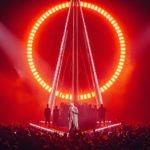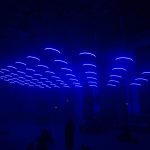Have you ever been so mad that you saw green?
Probably not. Green is supposed to be the most restful color to the eye because the lens of your eyes focus green right on the retina, and you know how much work it can be focusing all those heavy non-green photons. More likely, you’ve sat in a green room to calm down before an appearance on stage. You might have a greenhouse, or gotten the green light to join Greenpeace. Or perhaps you’re a greenhorn drinking green beer on Saint Patrick’s Day. If you’re lucky you might have a pocket full of greenbacks. Or if you’re environmentally conscious you might be working on a green lighting design. But if you’re angry you probably won’t see green.
There are many colorful metaphors that borrow from the power of colors, but is there any truth behind them? For color to be used effectively in production design, it helps to understand the difference between the physics of color, the physiological reactions to certain colors, color symbolism and myth. If the color green is a restful color, why do you get “green around the gills” when you’re seasick?
Have you ever been blue with envy?
I’m guessing not. Blue light has been found to suppress sleepiness in some studies, and the color blue is said to suppress your appetite, but it has not, as far as I know, ever been associated with envy. It has, however, been associated with importance, confidence, trust and technology. That’s why it’s the preferred color of big business and law enforcement. Think Big Blue, as in IBM. That’s the power of symbolism in color.
Can blue light be special? K-Mart thinks so. So did the ancient Romans, who associated the color with the robes of a philosopher. It’s also the color of immortality in China, it signifies holiness to the Hebrews and it’s the color of Krishna in Hinduism. But it’s not usually associated with an appetizing meal. Blue is seldom found naturally in food, which is why ZZ Top, who likes TV dinners, only likes the chicken if the sauce is not too blue.
Blue light is difficult for the eye to focus because it’s highly refracted. That’s an example of the physics of color. It makes the lens of the eye flatten out and it creates a soft focus, which is why it’s the preferred color of many dancers at nudie bars (or so I’m told—not like I’ve ever been . . . lately). Blue is a receding color; blue objects tend to appear to be pushed into the background. That’s why blue makes a great background color.
Have you ever had a bad case of the reds?
If you have, then your pulse probably rose, your metabolism sped up and your appetite increased. That’s an example of the physiological reaction to a color. Red is an aggressive color with warmth and energy. It’s the color of fire, blood, rebellion, combat, prostitution, strength and dominance. In the ‘80s, people like Pat Benatar made red and black the color of new wave, edgy rock and roll. But red has always been associated with passion and excitement, thus the popularity of ruby red lips and little red sports cars.
Red is an advancing color, which makes it difficult to use effectively as a background color because it will fight with the subject. So unless you want an aggressive look that raises the energy of the room, then a solid red wash might be used carefully.
Purple is a favorite color for many people and it’s easy to see why. It’s been associated with mysticism, passion, spirituality, creativity, imagination and in some places, mo u r n – ing and d e a t h . It rarely occurs in n a t u r e , and in the ancient civilization of Crete, purple dye was made from the mucus of the Murex mollusk. It took about 12,000 of them to make 1.5 grams of dye, thus it was a very rare commodity which only the rich could afford. That’s why it has been associated with royalty.
Today, various shades of purple can be mixed with most any decent color mixing system. Does it still evoke a strong association with royalty?
Yellow is the most luminous of all colors. That’s why it’s used to signal caution in traffic signals, road signs and quarantine flags (do not cross the yellow police line!). In China, yellow is symbolic of the emperor and in Hindu it’s a sacred color. To the eye, the color yellow is the first color it sees and it is the most visible color in the spectrum.
How does all of this come into play on the stage? You have to wonder about the strength or weakness of the physiological, physical and symbolic associations of colors. How long do you have to stare at a green wash before it has a calming effect? If I’m immersed in a red wash, do I only think about having a snack, or do I get up and go to the concession stand? And just how green do my gills get when I’m seasick?
All of these questions and more are begging to be answered. Reading about them is one thing, but experience is the best teacher. Learning about physiological reactions, physical characteristics and color symbolism along with your experience using color will train your eye to use color effectively.
Color my world with the hope of getting an e-mail from you: rcadena@plsn.com.


